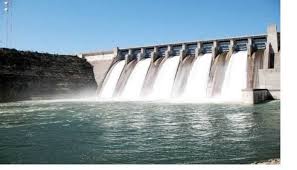CHIEF Mawere, Elliot Jawanda (81) looked hopefully at two recently installed Centre Pivots that are expected to water 156 hectares of land in the extremely dry Mwenezi District; teary-eyed he told journalists this was the end of his people’s continued vulnerability to climate-related changes.
Some 300 households are expected to benefit from the scheme, named Pikinini-Jawanda in reference to the two villages from which beneficiaries will be picked.
This scheme meant as an initiative to build climate change resilience, is the culmination of a 1985 plan to irrigate the area around Manyuchi Dam. Already pipes have been laid from the source to large tracts of land cleared by hundreds of eager villagers.
The El Nino has been ruthless in Chief Mawarire’s area such that none of his headmen are yet to record a successful harvest in their villages. The scorching heat and barely noticeable rains are not what villagers said they experienced growing up.
To note is that the area is relatively dry, being in Zimbabwe’s Natural Region Five which receives just 650mm of rain per year. Because of this, crop yields are low and risk of crop failure is high one in three years according to United Nations (UN) agency Food and Agriculture Organisation (FAO).
The Centre Pivots, which will use water from Manyuchi Dam, are a product of the government, United Nations Development Programme (UNDP) and Green Climate Fund (GCF) investments in Chief Mawarire’s area.
“This area has a lot of poverty, a lot of hunger. This irrigation scheme will mark an end to this, we will now be able to till our land at least thrice a year and make sure hunger in Mawarire becomes a thing of the past,” said Chief Mawarire.
“The weather patterns have changed, the heat has destroyed all our crops and we are already banking on the government’s food aid scheme to survive.”
Fields toured by- revealed that Chief Mawarire’s fears were founded. None of those who planted maize, a staple diet in Zimbabwe and especially rural areas such as Mwenezi, recorded good harvests which is a sure sign things might not be well this year.
Maize stalks are stunted, leaves are dry while others did not germinate. The fields are so dry, that villagers forwent tilling.
Already 3.8 million people in rural areas are said to be at risk of food insecurity according to the UN agency World Food Programme (WFP), with some urban dwellers in a similar situation.
“This region has a background of failing to produce, they survive on handouts from the government’s social welfare department but having such an irrigation plant means they will be able to diversify their farming to maize meal, wheat and green beans which are also very profitable,” said Masvingo’s Provincial Focal Person for GCF projects in the Agriculture Ministry Rangarirai Mutusva.
“Having this system is a good measure in curbing challenges of climate change. If our dam is full then we are guaranteed a bumper harvest each farming season.
“We have dealt with the adverse effects of climate change and if this is properly implemented the lives of people in this area will be changed.”
The hunger stalking Zimbabwe was declared a State of National Disaster by President Emmerson Mnangagwa on April 2.
According to UNDP Communications Associate Anesu Freddy, government picked Mwenezi District for the ongoing project because of the impact climate change has had on villagers.
Themed “Building Climate Resilience of Vulnerable Agricultural Livelihoods in Southern Zimbabwe,’ the project which started in 2020 is expected to end in 2027 targeting communities in Masvingo, Manicaland and Matabeleland South Provinces.
“We want to assist farmers in this region, ensuring that they are not left behind in regards to development and developing farming methods,” said Freddy.
The project has three objectives, increasing access to irrigation, increasing access to climate information and training farmers in climate-smart agricultural practices.
“We are a farming community, we have been surviving on that but hope is that this project will ensure that our crops survive the heat,” said 22-year-old Mary Jakarasi, one of the young women expected to benefit from the scheme.
“We grew maize but it was burnt while a few who grew sorghum and other smaller grains could have a better harvest, next farming season will be better for all of us.”
SOURCE : NEW ZIMBABWE










